Fire Safety Analysis: Buncefield Oil Depot Incident Report
VerifiedAdded on 2022/07/29
|11
|2252
|25
Report
AI Summary
This report provides a detailed analysis of the Buncefield oil depot fire, examining the events leading to the explosion and subsequent fire. It discusses the site layout, the sequence of events, and the behavior of the smoke plume, including its spread and impact. The report further explores the rate of heat release, the effects of the smoke, and the fire protection materials used. It also emphasizes the importance of good practices for the safety of industrial plant layouts, including areas for improvement. The conclusion highlights the potential for the propagation of such fires and the widespread effects of pollutants, offering insights into preventing similar incidents in the future. The report references various sources to support its findings, providing a comprehensive overview of the incident and related safety concerns.
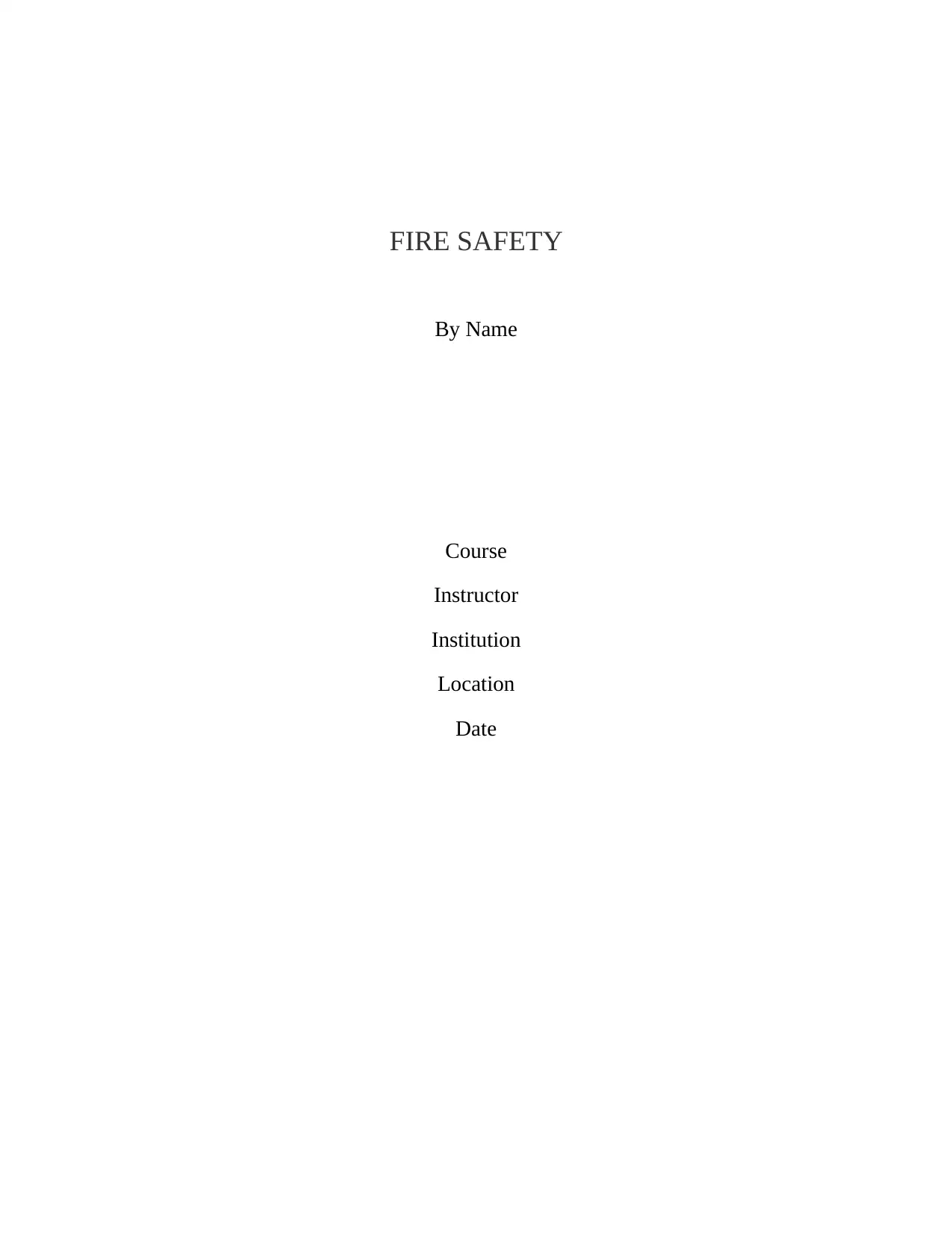
FIRE SAFETY
By Name
Course
Instructor
Institution
Location
Date
By Name
Course
Instructor
Institution
Location
Date
Paraphrase This Document
Need a fresh take? Get an instant paraphrase of this document with our AI Paraphraser
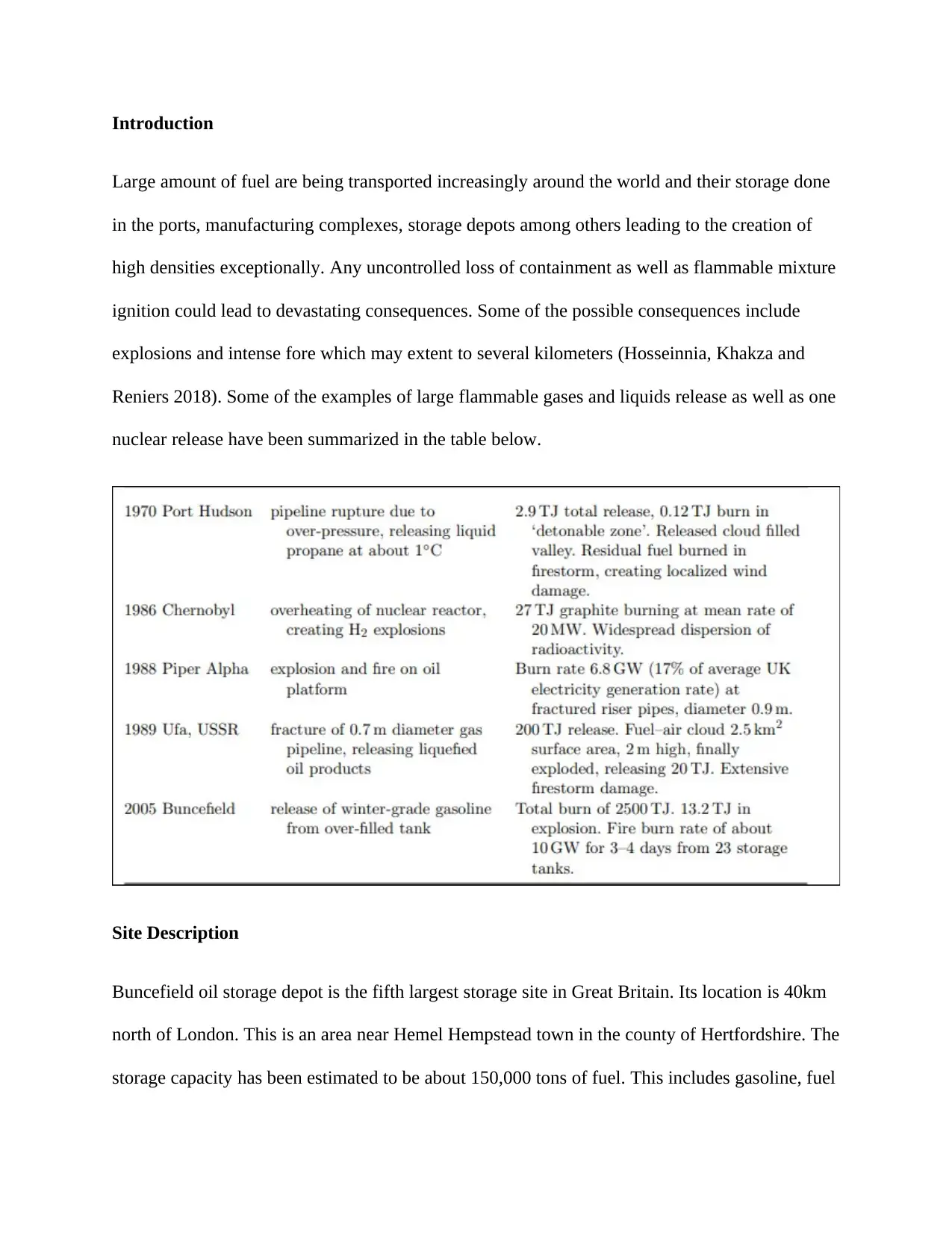
Introduction
Large amount of fuel are being transported increasingly around the world and their storage done
in the ports, manufacturing complexes, storage depots among others leading to the creation of
high densities exceptionally. Any uncontrolled loss of containment as well as flammable mixture
ignition could lead to devastating consequences. Some of the possible consequences include
explosions and intense fore which may extent to several kilometers (Hosseinnia, Khakza and
Reniers 2018). Some of the examples of large flammable gases and liquids release as well as one
nuclear release have been summarized in the table below.
Site Description
Buncefield oil storage depot is the fifth largest storage site in Great Britain. Its location is 40km
north of London. This is an area near Hemel Hempstead town in the county of Hertfordshire. The
storage capacity has been estimated to be about 150,000 tons of fuel. This includes gasoline, fuel
Large amount of fuel are being transported increasingly around the world and their storage done
in the ports, manufacturing complexes, storage depots among others leading to the creation of
high densities exceptionally. Any uncontrolled loss of containment as well as flammable mixture
ignition could lead to devastating consequences. Some of the possible consequences include
explosions and intense fore which may extent to several kilometers (Hosseinnia, Khakza and
Reniers 2018). Some of the examples of large flammable gases and liquids release as well as one
nuclear release have been summarized in the table below.
Site Description
Buncefield oil storage depot is the fifth largest storage site in Great Britain. Its location is 40km
north of London. This is an area near Hemel Hempstead town in the county of Hertfordshire. The
storage capacity has been estimated to be about 150,000 tons of fuel. This includes gasoline, fuel

oil, and kerosene. The total capacity is thus 273,000 m3. The deport has been distinctively
known for the supply of kerosene through infrastructure of pipelines to areas like Heathrow and
London's Luton airports with the former being the busiest and the largest. There has also been an
implementation of the system backup in the case of the case of their supply systems.
Figure 1: Site layout
The depot of the oil storage is known to house three companies as indicated in the diagram
above. This constitutes three pipes for the supply as well as two pipelines used for the purposes
of the distribution. The site of the company where there was occurrence of the accident is
basically divided into two sections.
known for the supply of kerosene through infrastructure of pipelines to areas like Heathrow and
London's Luton airports with the former being the busiest and the largest. There has also been an
implementation of the system backup in the case of the case of their supply systems.
Figure 1: Site layout
The depot of the oil storage is known to house three companies as indicated in the diagram
above. This constitutes three pipes for the supply as well as two pipelines used for the purposes
of the distribution. The site of the company where there was occurrence of the accident is
basically divided into two sections.
⊘ This is a preview!⊘
Do you want full access?
Subscribe today to unlock all pages.

Trusted by 1+ million students worldwide

The Western part: It covers at least 16 fuel oil tanks with the; capacity of about 58,000 m3. This
is stationed along with the stations of the truck filling, installations of the pipeline receptions
with at least control room and 3 smaller admixture tanks.
The Eastern part: It has seven kerosene and fuel oil tanks with the total capacity of 26000m3.
The operation of the company is usually for a period of 24hrs. The oil storage depot which is
ranked second is located between the western and the eastern sites of the company which
incurred the losses. This particular depot had been authorized to handle a capacity of 70,000 tons
of fuel.
The accident
Events sequence
At around 7:00p.m on the month of December 10th there was reception of unleaded gasoline by
Tank 912. This particular tank is located in the company’s first storage area marked as area, A.
The delivery was done at an inflow rate of about 550 550 m3 /hr.
On December 11, at around midnight there was closure of the storage site with the verification of
the inventory being underway. There was indication of a stable of stable volume at the capacity
of 2/3 by Tank 912 at around 3:00 a.m. In the meanwhile, the delivery of the supply was
maintained at the same rate of flow. Tank 912 began to overflow at around 5:20a.m. This was
characterized by the formation of a high concentration of air/fuel mixture.
There was halting of a parallel supply delivery of another tank at 5:50a.m. This basically implied
that Tank 912 had its inflow rate at 890 m3 /hr. The supply valve of the tank however remained
opened.
is stationed along with the stations of the truck filling, installations of the pipeline receptions
with at least control room and 3 smaller admixture tanks.
The Eastern part: It has seven kerosene and fuel oil tanks with the total capacity of 26000m3.
The operation of the company is usually for a period of 24hrs. The oil storage depot which is
ranked second is located between the western and the eastern sites of the company which
incurred the losses. This particular depot had been authorized to handle a capacity of 70,000 tons
of fuel.
The accident
Events sequence
At around 7:00p.m on the month of December 10th there was reception of unleaded gasoline by
Tank 912. This particular tank is located in the company’s first storage area marked as area, A.
The delivery was done at an inflow rate of about 550 550 m3 /hr.
On December 11, at around midnight there was closure of the storage site with the verification of
the inventory being underway. There was indication of a stable of stable volume at the capacity
of 2/3 by Tank 912 at around 3:00 a.m. In the meanwhile, the delivery of the supply was
maintained at the same rate of flow. Tank 912 began to overflow at around 5:20a.m. This was
characterized by the formation of a high concentration of air/fuel mixture.
There was halting of a parallel supply delivery of another tank at 5:50a.m. This basically implied
that Tank 912 had its inflow rate at 890 m3 /hr. The supply valve of the tank however remained
opened.
Paraphrase This Document
Need a fresh take? Get an instant paraphrase of this document with our AI Paraphraser
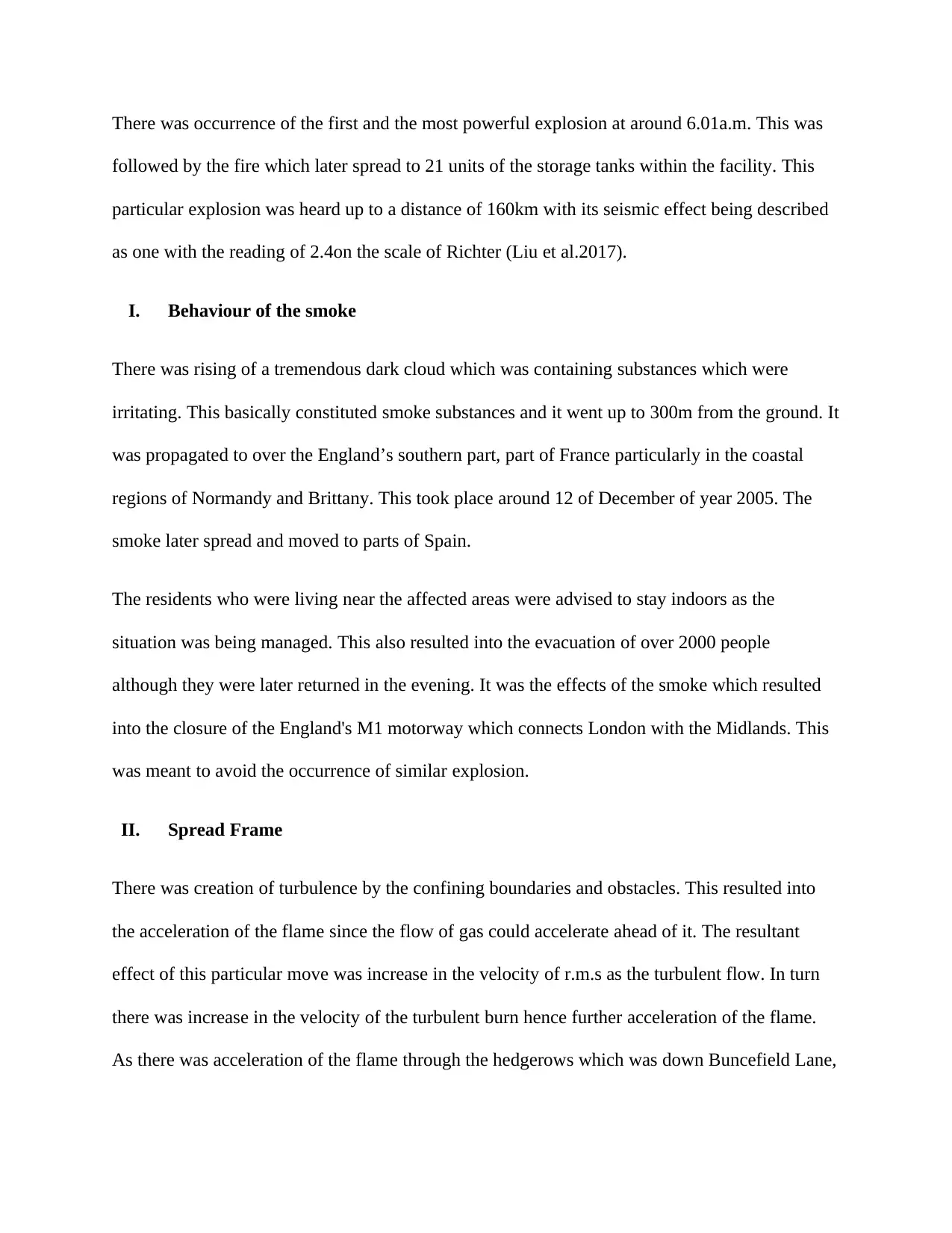
There was occurrence of the first and the most powerful explosion at around 6.01a.m. This was
followed by the fire which later spread to 21 units of the storage tanks within the facility. This
particular explosion was heard up to a distance of 160km with its seismic effect being described
as one with the reading of 2.4on the scale of Richter (Liu et al.2017).
I. Behaviour of the smoke
There was rising of a tremendous dark cloud which was containing substances which were
irritating. This basically constituted smoke substances and it went up to 300m from the ground. It
was propagated to over the England’s southern part, part of France particularly in the coastal
regions of Normandy and Brittany. This took place around 12 of December of year 2005. The
smoke later spread and moved to parts of Spain.
The residents who were living near the affected areas were advised to stay indoors as the
situation was being managed. This also resulted into the evacuation of over 2000 people
although they were later returned in the evening. It was the effects of the smoke which resulted
into the closure of the England's M1 motorway which connects London with the Midlands. This
was meant to avoid the occurrence of similar explosion.
II. Spread Frame
There was creation of turbulence by the confining boundaries and obstacles. This resulted into
the acceleration of the flame since the flow of gas could accelerate ahead of it. The resultant
effect of this particular move was increase in the velocity of r.m.s as the turbulent flow. In turn
there was increase in the velocity of the turbulent burn hence further acceleration of the flame.
As there was acceleration of the flame through the hedgerows which was down Buncefield Lane,
followed by the fire which later spread to 21 units of the storage tanks within the facility. This
particular explosion was heard up to a distance of 160km with its seismic effect being described
as one with the reading of 2.4on the scale of Richter (Liu et al.2017).
I. Behaviour of the smoke
There was rising of a tremendous dark cloud which was containing substances which were
irritating. This basically constituted smoke substances and it went up to 300m from the ground. It
was propagated to over the England’s southern part, part of France particularly in the coastal
regions of Normandy and Brittany. This took place around 12 of December of year 2005. The
smoke later spread and moved to parts of Spain.
The residents who were living near the affected areas were advised to stay indoors as the
situation was being managed. This also resulted into the evacuation of over 2000 people
although they were later returned in the evening. It was the effects of the smoke which resulted
into the closure of the England's M1 motorway which connects London with the Midlands. This
was meant to avoid the occurrence of similar explosion.
II. Spread Frame
There was creation of turbulence by the confining boundaries and obstacles. This resulted into
the acceleration of the flame since the flow of gas could accelerate ahead of it. The resultant
effect of this particular move was increase in the velocity of r.m.s as the turbulent flow. In turn
there was increase in the velocity of the turbulent burn hence further acceleration of the flame.
As there was acceleration of the flame through the hedgerows which was down Buncefield Lane,
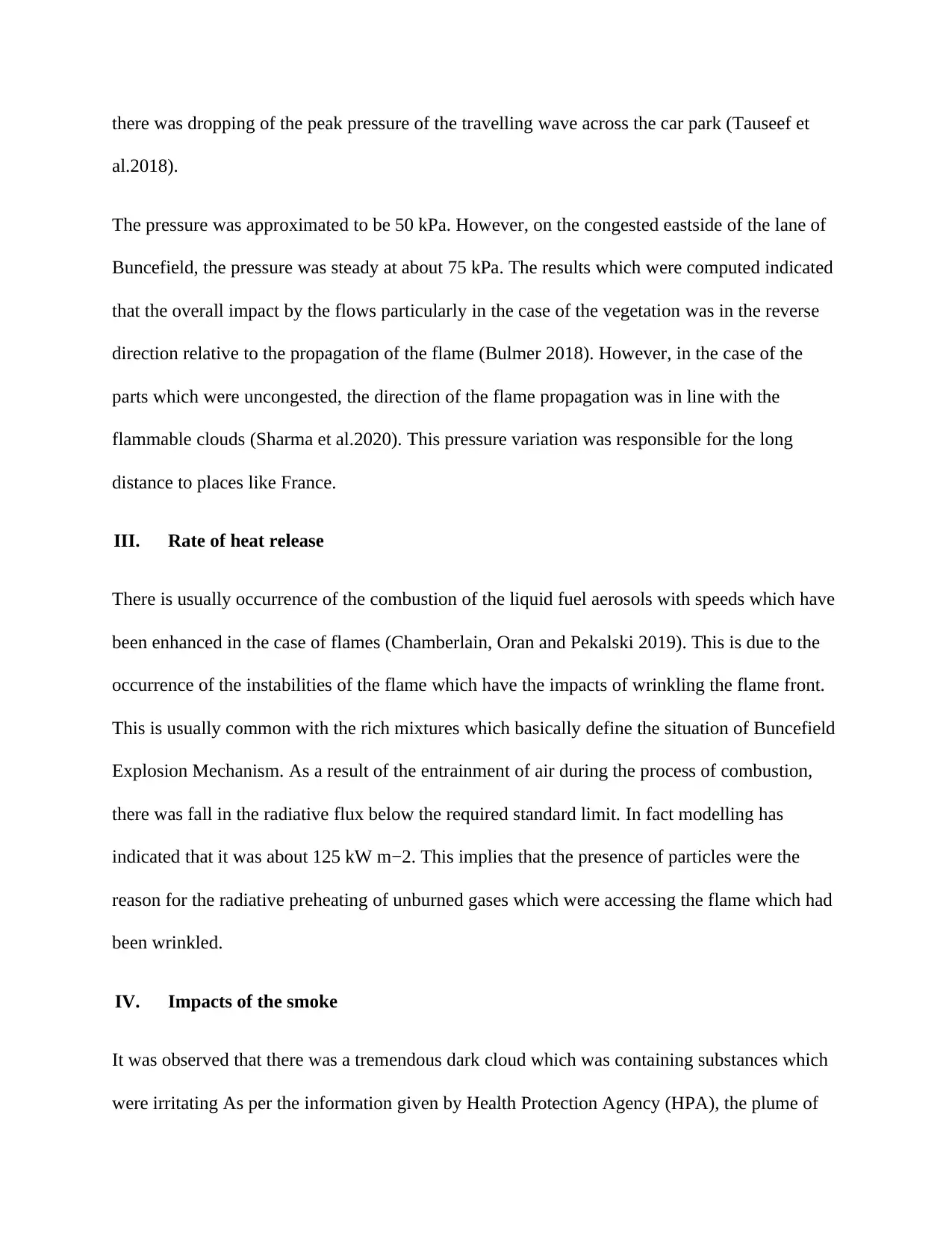
there was dropping of the peak pressure of the travelling wave across the car park (Tauseef et
al.2018).
The pressure was approximated to be 50 kPa. However, on the congested eastside of the lane of
Buncefield, the pressure was steady at about 75 kPa. The results which were computed indicated
that the overall impact by the flows particularly in the case of the vegetation was in the reverse
direction relative to the propagation of the flame (Bulmer 2018). However, in the case of the
parts which were uncongested, the direction of the flame propagation was in line with the
flammable clouds (Sharma et al.2020). This pressure variation was responsible for the long
distance to places like France.
III. Rate of heat release
There is usually occurrence of the combustion of the liquid fuel aerosols with speeds which have
been enhanced in the case of flames (Chamberlain, Oran and Pekalski 2019). This is due to the
occurrence of the instabilities of the flame which have the impacts of wrinkling the flame front.
This is usually common with the rich mixtures which basically define the situation of Buncefield
Explosion Mechanism. As a result of the entrainment of air during the process of combustion,
there was fall in the radiative flux below the required standard limit. In fact modelling has
indicated that it was about 125 kW m−2. This implies that the presence of particles were the
reason for the radiative preheating of unburned gases which were accessing the flame which had
been wrinkled.
IV. Impacts of the smoke
It was observed that there was a tremendous dark cloud which was containing substances which
were irritating As per the information given by Health Protection Agency (HPA), the plume of
al.2018).
The pressure was approximated to be 50 kPa. However, on the congested eastside of the lane of
Buncefield, the pressure was steady at about 75 kPa. The results which were computed indicated
that the overall impact by the flows particularly in the case of the vegetation was in the reverse
direction relative to the propagation of the flame (Bulmer 2018). However, in the case of the
parts which were uncongested, the direction of the flame propagation was in line with the
flammable clouds (Sharma et al.2020). This pressure variation was responsible for the long
distance to places like France.
III. Rate of heat release
There is usually occurrence of the combustion of the liquid fuel aerosols with speeds which have
been enhanced in the case of flames (Chamberlain, Oran and Pekalski 2019). This is due to the
occurrence of the instabilities of the flame which have the impacts of wrinkling the flame front.
This is usually common with the rich mixtures which basically define the situation of Buncefield
Explosion Mechanism. As a result of the entrainment of air during the process of combustion,
there was fall in the radiative flux below the required standard limit. In fact modelling has
indicated that it was about 125 kW m−2. This implies that the presence of particles were the
reason for the radiative preheating of unburned gases which were accessing the flame which had
been wrinkled.
IV. Impacts of the smoke
It was observed that there was a tremendous dark cloud which was containing substances which
were irritating As per the information given by Health Protection Agency (HPA), the plume of
⊘ This is a preview!⊘
Do you want full access?
Subscribe today to unlock all pages.

Trusted by 1+ million students worldwide
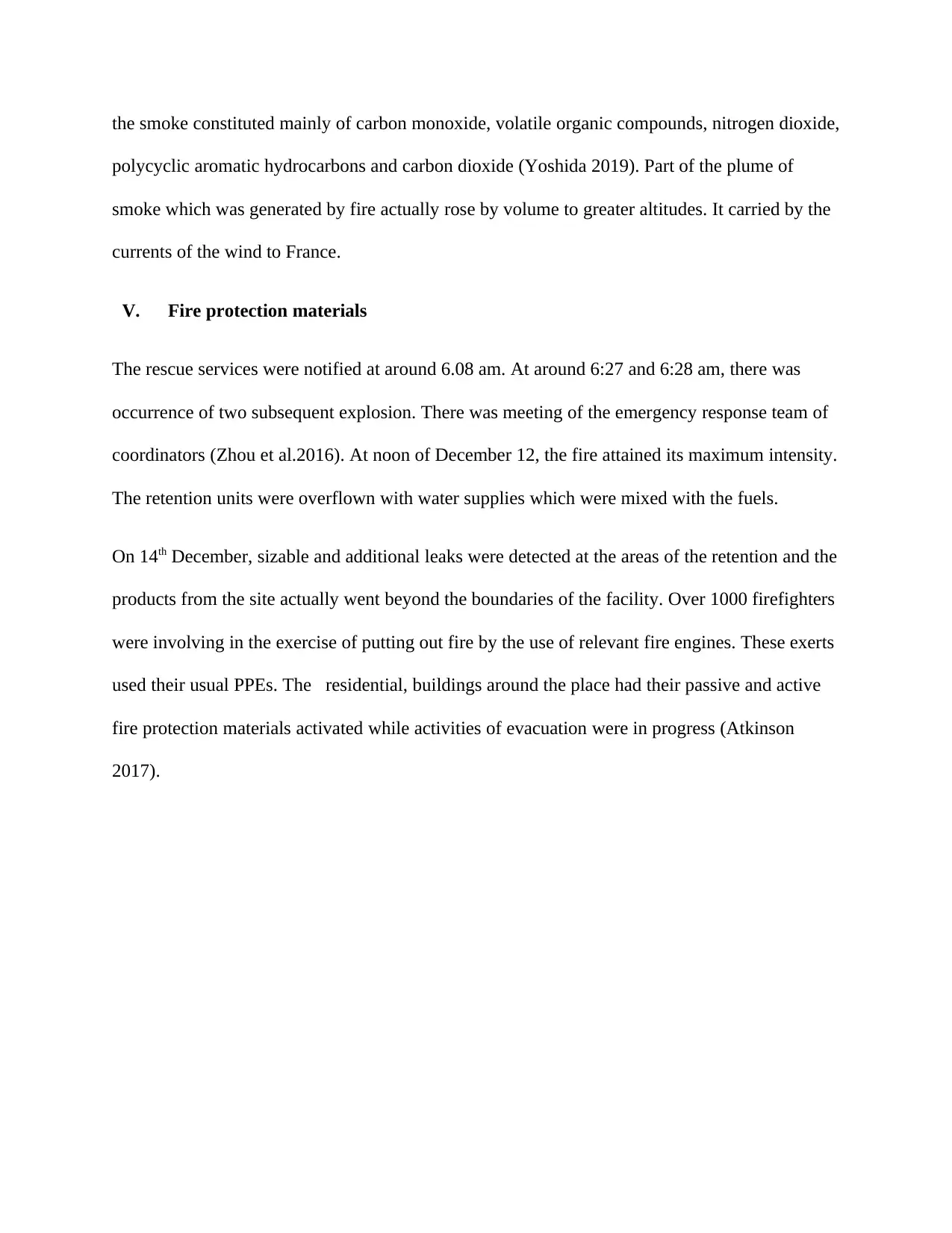
the smoke constituted mainly of carbon monoxide, volatile organic compounds, nitrogen dioxide,
polycyclic aromatic hydrocarbons and carbon dioxide (Yoshida 2019). Part of the plume of
smoke which was generated by fire actually rose by volume to greater altitudes. It carried by the
currents of the wind to France.
V. Fire protection materials
The rescue services were notified at around 6.08 am. At around 6:27 and 6:28 am, there was
occurrence of two subsequent explosion. There was meeting of the emergency response team of
coordinators (Zhou et al.2016). At noon of December 12, the fire attained its maximum intensity.
The retention units were overflown with water supplies which were mixed with the fuels.
On 14th December, sizable and additional leaks were detected at the areas of the retention and the
products from the site actually went beyond the boundaries of the facility. Over 1000 firefighters
were involving in the exercise of putting out fire by the use of relevant fire engines. These exerts
used their usual PPEs. The residential, buildings around the place had their passive and active
fire protection materials activated while activities of evacuation were in progress (Atkinson
2017).
polycyclic aromatic hydrocarbons and carbon dioxide (Yoshida 2019). Part of the plume of
smoke which was generated by fire actually rose by volume to greater altitudes. It carried by the
currents of the wind to France.
V. Fire protection materials
The rescue services were notified at around 6.08 am. At around 6:27 and 6:28 am, there was
occurrence of two subsequent explosion. There was meeting of the emergency response team of
coordinators (Zhou et al.2016). At noon of December 12, the fire attained its maximum intensity.
The retention units were overflown with water supplies which were mixed with the fuels.
On 14th December, sizable and additional leaks were detected at the areas of the retention and the
products from the site actually went beyond the boundaries of the facility. Over 1000 firefighters
were involving in the exercise of putting out fire by the use of relevant fire engines. These exerts
used their usual PPEs. The residential, buildings around the place had their passive and active
fire protection materials activated while activities of evacuation were in progress (Atkinson
2017).
Paraphrase This Document
Need a fresh take? Get an instant paraphrase of this document with our AI Paraphraser
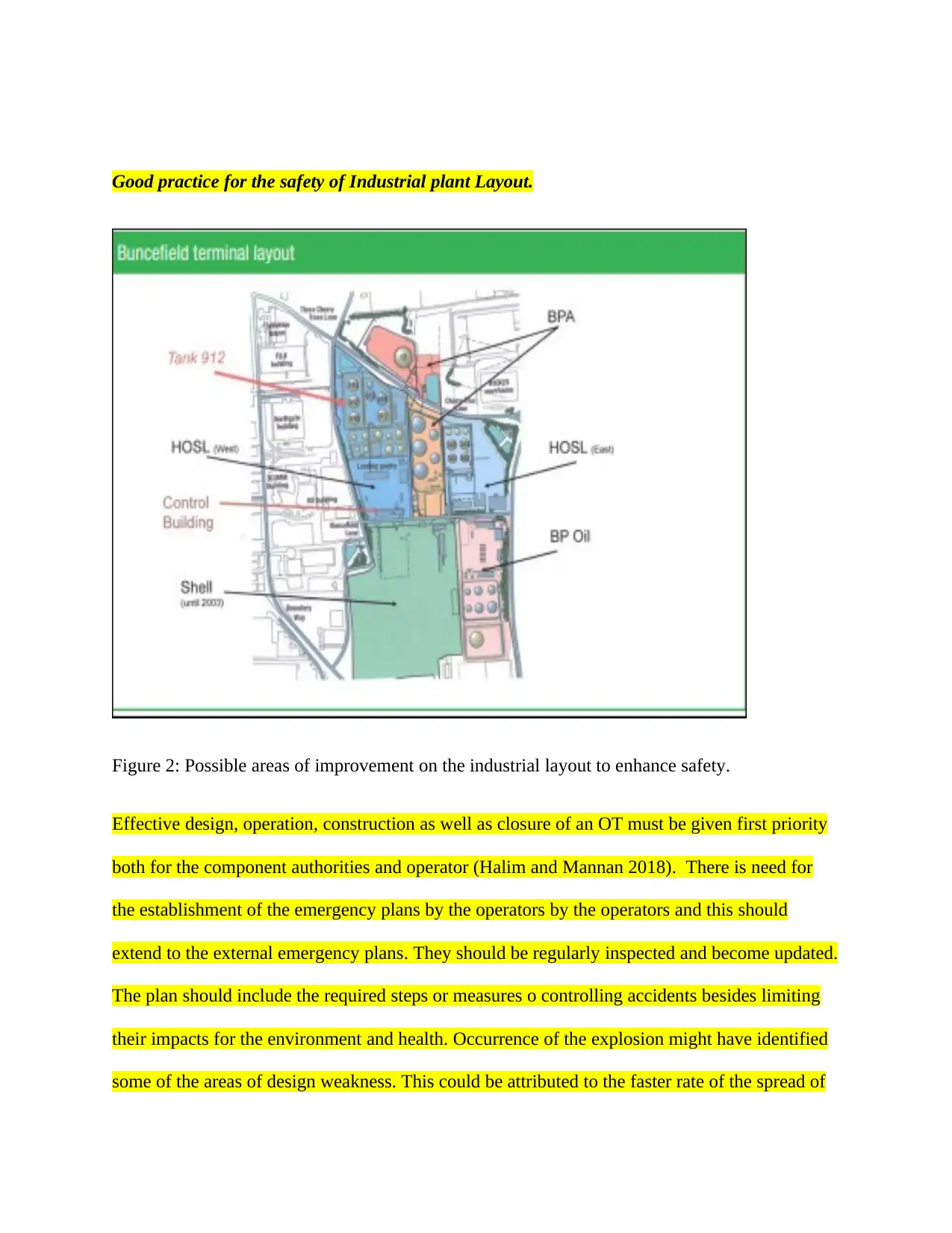
Good practice for the safety of Industrial plant Layout.
Figure 2: Possible areas of improvement on the industrial layout to enhance safety.
Effective design, operation, construction as well as closure of an OT must be given first priority
both for the component authorities and operator (Halim and Mannan 2018). There is need for
the establishment of the emergency plans by the operators by the operators and this should
extend to the external emergency plans. They should be regularly inspected and become updated.
The plan should include the required steps or measures o controlling accidents besides limiting
their impacts for the environment and health. Occurrence of the explosion might have identified
some of the areas of design weakness. This could be attributed to the faster rate of the spread of
Figure 2: Possible areas of improvement on the industrial layout to enhance safety.
Effective design, operation, construction as well as closure of an OT must be given first priority
both for the component authorities and operator (Halim and Mannan 2018). There is need for
the establishment of the emergency plans by the operators by the operators and this should
extend to the external emergency plans. They should be regularly inspected and become updated.
The plan should include the required steps or measures o controlling accidents besides limiting
their impacts for the environment and health. Occurrence of the explosion might have identified
some of the areas of design weakness. This could be attributed to the faster rate of the spread of

fire. If the design as well as industrial layout would have been perfect then the rate of spread of
fire would be low.
As part of the addition to the changes of the layout, the local authorities should consider having
protective guards in between the consumer units. Planning and safety assumptions at the depots
of fuel like for the case of Buncefield has until now been based on the concept of fires in pools
which primarily escaped from the liquid. The layout should therefore consider adjusting on the
spaces of movement/corridors to allow for the movement of the fire engines. The initial layout
has only considered escape routes and this might have contributed significantly to the process
delay during fire extinguishing (Aloisio and Marais 2018).
Conclusion
Propagation of such fires like for the Buncefield circumtances could be facilitated by the
presence of the strength pressure waves beyond the vicinity of immediate reach. Similarly, the
spread of the pollutants could be beyond the unexpected distances. The global atmosphere can be
potentially affected by the interaction with fire.
fire would be low.
As part of the addition to the changes of the layout, the local authorities should consider having
protective guards in between the consumer units. Planning and safety assumptions at the depots
of fuel like for the case of Buncefield has until now been based on the concept of fires in pools
which primarily escaped from the liquid. The layout should therefore consider adjusting on the
spaces of movement/corridors to allow for the movement of the fire engines. The initial layout
has only considered escape routes and this might have contributed significantly to the process
delay during fire extinguishing (Aloisio and Marais 2018).
Conclusion
Propagation of such fires like for the Buncefield circumtances could be facilitated by the
presence of the strength pressure waves beyond the vicinity of immediate reach. Similarly, the
spread of the pollutants could be beyond the unexpected distances. The global atmosphere can be
potentially affected by the interaction with fire.
⊘ This is a preview!⊘
Do you want full access?
Subscribe today to unlock all pages.

Trusted by 1+ million students worldwide
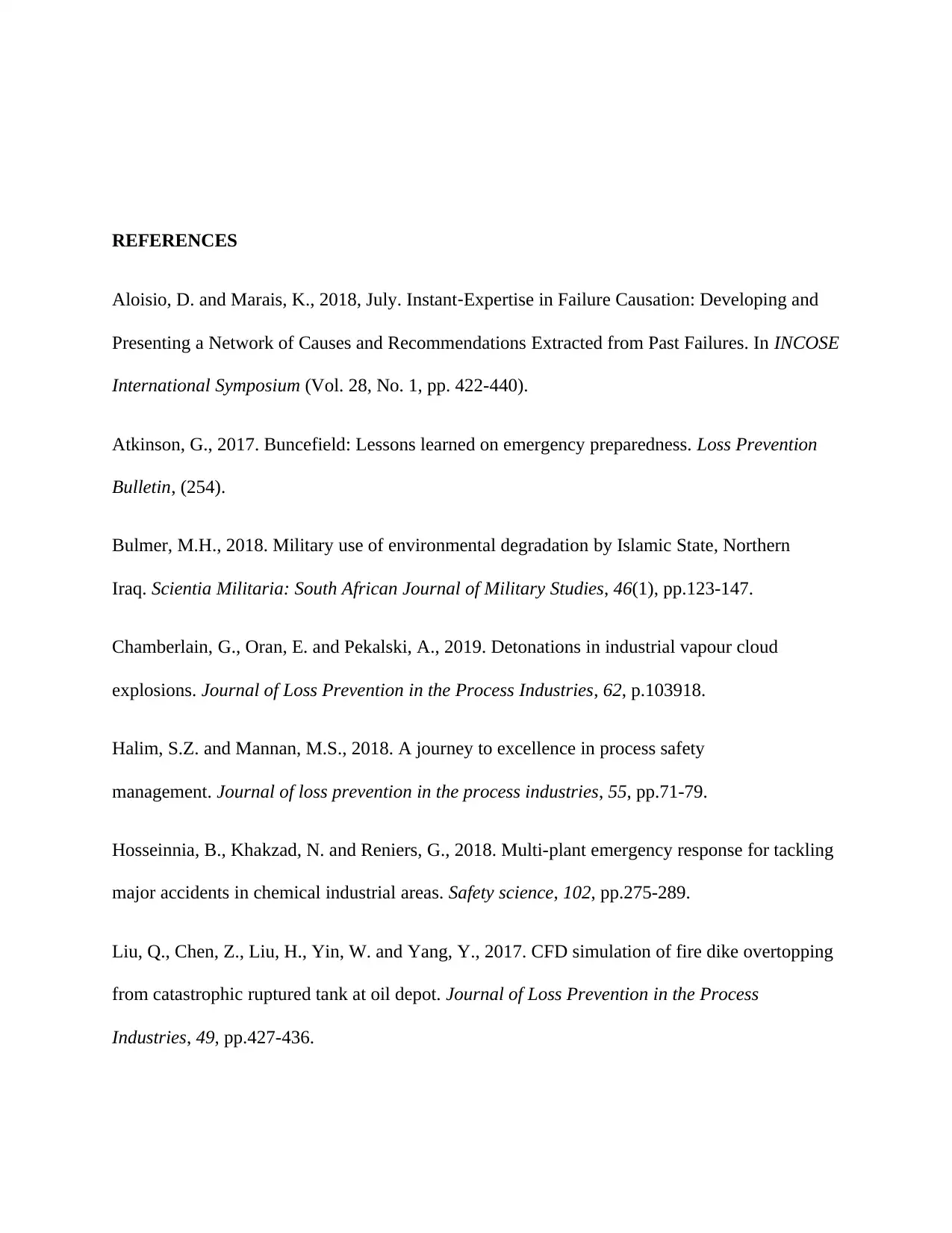
REFERENCES
Aloisio, D. and Marais, K., 2018, July. Instant‐Expertise in Failure Causation: Developing and
Presenting a Network of Causes and Recommendations Extracted from Past Failures. In INCOSE
International Symposium (Vol. 28, No. 1, pp. 422-440).
Atkinson, G., 2017. Buncefield: Lessons learned on emergency preparedness. Loss Prevention
Bulletin, (254).
Bulmer, M.H., 2018. Military use of environmental degradation by Islamic State, Northern
Iraq. Scientia Militaria: South African Journal of Military Studies, 46(1), pp.123-147.
Chamberlain, G., Oran, E. and Pekalski, A., 2019. Detonations in industrial vapour cloud
explosions. Journal of Loss Prevention in the Process Industries, 62, p.103918.
Halim, S.Z. and Mannan, M.S., 2018. A journey to excellence in process safety
management. Journal of loss prevention in the process industries, 55, pp.71-79.
Hosseinnia, B., Khakzad, N. and Reniers, G., 2018. Multi-plant emergency response for tackling
major accidents in chemical industrial areas. Safety science, 102, pp.275-289.
Liu, Q., Chen, Z., Liu, H., Yin, W. and Yang, Y., 2017. CFD simulation of fire dike overtopping
from catastrophic ruptured tank at oil depot. Journal of Loss Prevention in the Process
Industries, 49, pp.427-436.
Aloisio, D. and Marais, K., 2018, July. Instant‐Expertise in Failure Causation: Developing and
Presenting a Network of Causes and Recommendations Extracted from Past Failures. In INCOSE
International Symposium (Vol. 28, No. 1, pp. 422-440).
Atkinson, G., 2017. Buncefield: Lessons learned on emergency preparedness. Loss Prevention
Bulletin, (254).
Bulmer, M.H., 2018. Military use of environmental degradation by Islamic State, Northern
Iraq. Scientia Militaria: South African Journal of Military Studies, 46(1), pp.123-147.
Chamberlain, G., Oran, E. and Pekalski, A., 2019. Detonations in industrial vapour cloud
explosions. Journal of Loss Prevention in the Process Industries, 62, p.103918.
Halim, S.Z. and Mannan, M.S., 2018. A journey to excellence in process safety
management. Journal of loss prevention in the process industries, 55, pp.71-79.
Hosseinnia, B., Khakzad, N. and Reniers, G., 2018. Multi-plant emergency response for tackling
major accidents in chemical industrial areas. Safety science, 102, pp.275-289.
Liu, Q., Chen, Z., Liu, H., Yin, W. and Yang, Y., 2017. CFD simulation of fire dike overtopping
from catastrophic ruptured tank at oil depot. Journal of Loss Prevention in the Process
Industries, 49, pp.427-436.
Paraphrase This Document
Need a fresh take? Get an instant paraphrase of this document with our AI Paraphraser
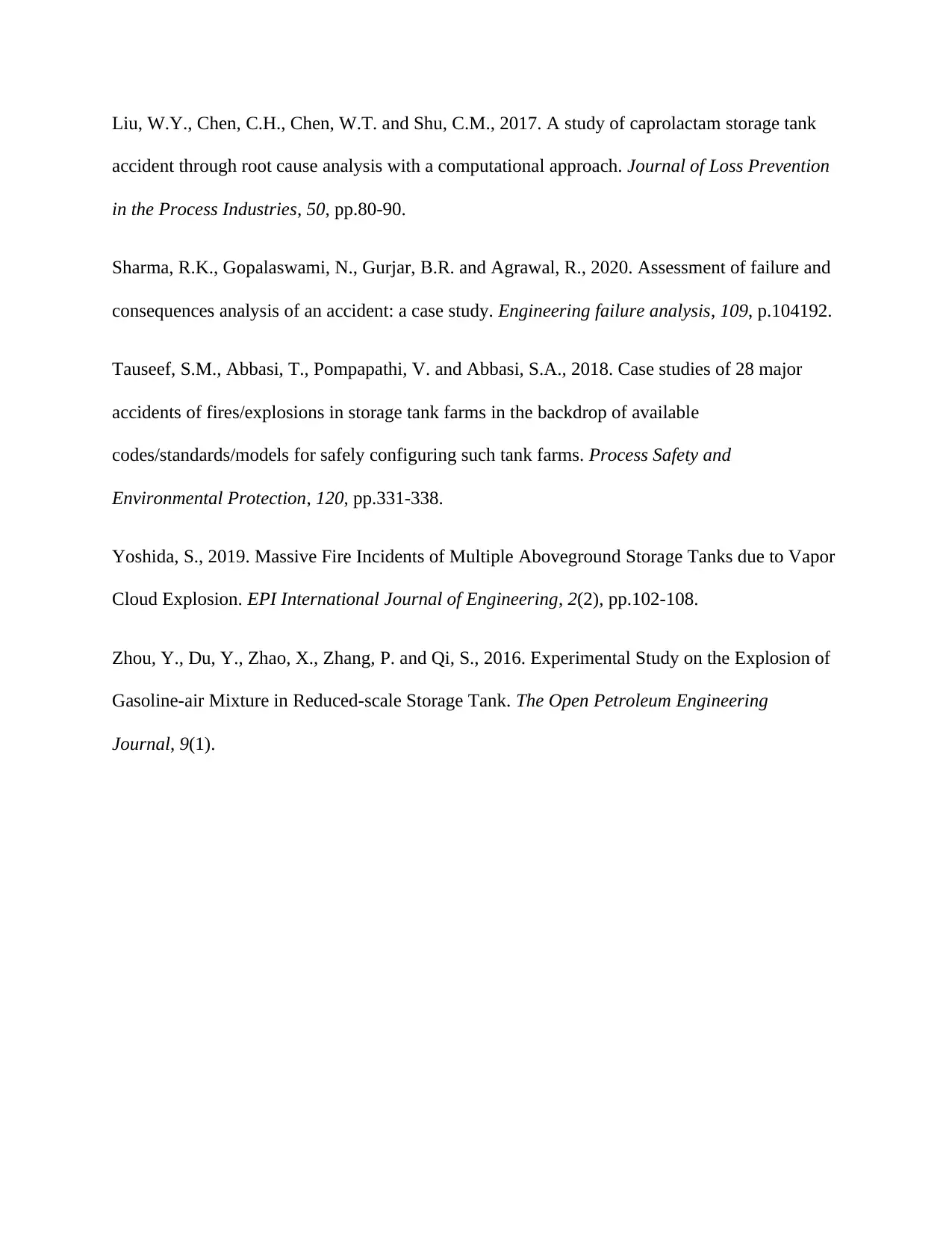
Liu, W.Y., Chen, C.H., Chen, W.T. and Shu, C.M., 2017. A study of caprolactam storage tank
accident through root cause analysis with a computational approach. Journal of Loss Prevention
in the Process Industries, 50, pp.80-90.
Sharma, R.K., Gopalaswami, N., Gurjar, B.R. and Agrawal, R., 2020. Assessment of failure and
consequences analysis of an accident: a case study. Engineering failure analysis, 109, p.104192.
Tauseef, S.M., Abbasi, T., Pompapathi, V. and Abbasi, S.A., 2018. Case studies of 28 major
accidents of fires/explosions in storage tank farms in the backdrop of available
codes/standards/models for safely configuring such tank farms. Process Safety and
Environmental Protection, 120, pp.331-338.
Yoshida, S., 2019. Massive Fire Incidents of Multiple Aboveground Storage Tanks due to Vapor
Cloud Explosion. EPI International Journal of Engineering, 2(2), pp.102-108.
Zhou, Y., Du, Y., Zhao, X., Zhang, P. and Qi, S., 2016. Experimental Study on the Explosion of
Gasoline-air Mixture in Reduced-scale Storage Tank. The Open Petroleum Engineering
Journal, 9(1).
accident through root cause analysis with a computational approach. Journal of Loss Prevention
in the Process Industries, 50, pp.80-90.
Sharma, R.K., Gopalaswami, N., Gurjar, B.R. and Agrawal, R., 2020. Assessment of failure and
consequences analysis of an accident: a case study. Engineering failure analysis, 109, p.104192.
Tauseef, S.M., Abbasi, T., Pompapathi, V. and Abbasi, S.A., 2018. Case studies of 28 major
accidents of fires/explosions in storage tank farms in the backdrop of available
codes/standards/models for safely configuring such tank farms. Process Safety and
Environmental Protection, 120, pp.331-338.
Yoshida, S., 2019. Massive Fire Incidents of Multiple Aboveground Storage Tanks due to Vapor
Cloud Explosion. EPI International Journal of Engineering, 2(2), pp.102-108.
Zhou, Y., Du, Y., Zhao, X., Zhang, P. and Qi, S., 2016. Experimental Study on the Explosion of
Gasoline-air Mixture in Reduced-scale Storage Tank. The Open Petroleum Engineering
Journal, 9(1).
1 out of 11
Your All-in-One AI-Powered Toolkit for Academic Success.
+13062052269
info@desklib.com
Available 24*7 on WhatsApp / Email
![[object Object]](/_next/static/media/star-bottom.7253800d.svg)
Unlock your academic potential
Copyright © 2020–2025 A2Z Services. All Rights Reserved. Developed and managed by ZUCOL.
